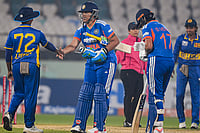“You have the royal bearing of a prince but I want an older look (to play Prince Salim),” director K Asif told Dilip Kumar sometime in 1947-48 in the context of his new project. Asif announced the film soon after, but financial hurdles stalled the project. But Filmistan released their super-hit musical Anarkali in 1953, stealing Asif’s thunder. But did it?
In that same meeting in 1947-48 with Kumar, Asif had prophesied that in the future he would make a film around the Salim-Anarkali love story at an awe-inspiring scale and that he would cast him as the romantic prince Salim. Kumar was amused but did not show it. A few years later, Asif kept the promise. Mughal-E-Azam, released to unprecedented reception on August 5, 1960, ranks as one of Bollywood’s towering commercial and critical successes ever — and makes for interesting debates and discussions over coffee.
Firstly, the film’s credits make no mention of any adaptation from Imtiaz Ali Taj’s 1922 Urdu play ‘Anarkali’, contrary to urban legends. According to film historian Kaushik Bhaumik, film producer Himanshu Rai adapted Taj’s play for his 1928 silent film Anarkali aka The Loves of a Mughal Prince which was reportedly never released. It was remade in 1933 in the talkie era. And then neither the 1953 version Anarkali by Filmistan starring Pradeep Kumar and Bina Rai nor Mughal-E-Azam (1960) made any reference to the play.

Secondly, some of the key members of the crew were not exactly in the best of relations with each other. By Kumar’s own admission, he and Asif were poles apart intellectually and temperamentally. Knowing that he was not going to get much help from Asif, Kumar delved into books in the Anjuman Islam School Library to learn descriptions of Salim and created a persona who closely matched those descriptions.
The announcement of the pairing of Madhubala and Kumar for Mughal-E-Azam generated great publicity because of reports of the emotional involvement between them. Asif was not only happy at this publicity, but he also decided to catalyse things by suggesting to Madhubala that she drew Kumar into physical intimacy to draw a commitment from him. In reality, things between Kumar and Madhubala gradually deteriorated to an extent that by the time that famous romantic sequence with the white feather between their lips was shot, they had even stopped exchanging pleasantries.
And now for the characters of the magnum opus.
Emperor Akbar: He was a secular ruler tolerant of all religions and loved Hindustan. Yet, he was authoritative and autocratic, refusing to tolerate dissent. If we strip his grandeur and imperialism, he was no different from wealthy Mr. Nath (Pran) in Bobby (1973) who objected with all his might to his son dating a fisherman’s daughter.
Now marrying a commoner was not uncommon among Mughal or Muslim rulers. So why did Akbar go to the extent of waging a war against his own son over a family matter? Did Akbar feel that since she was a kaneez (servant) and dancing girl in his court, he owned her? British historian Alex von Tunzelmann’s account suggests that Anarkali one of Akbar’s wives and the mother of Salim’s half-brother Prince Daniyal. So the thought of his son marrying Anarkali was incestuous and therefore abhorrent to Akbar.

Anarkali: There are no more than wisps of historical evidence of any real-life Anarkali. Assuming that Anarkali was not one of Akbar’s wives, why would a commoner not aspire to marry into royalty and win the status of the queen of the heir apparent of Hindustan? Anarkali was justified in making her point fearlessly to Akbar in an open forum through the song Jab Pyar Kiya to Darna Kya.
Salim: On the face of it, he was a tragic lover. But scenes of his childhood (played by a young Jalal Agha) showed him to be indulgent and lazy, nestling into a lifestyle of wine and dancing girls. And historical accounts suggest he continued to be brutal and vindictive even as a grown up. But these were obviously tempered down in the film. And yes, the real Prince Salim did lead a rebellion against his father but that it was over Anarkali is inaccurate.

These inconsistencies with real history would not have been necessary if Asif had made a disclaimer of the story of Mughal-E-Azam not having any foundation in history. This is something which the makers of Anarkali (1953) did in the closing credits.
But Asif didn’t.
(Balaji Vittal is a national award and MAMI-winning writer whose fifth book ‘Pure Evil’ released last year. He can be found on Twitter at @vittalbalaji. Views expressed are personal.)

























